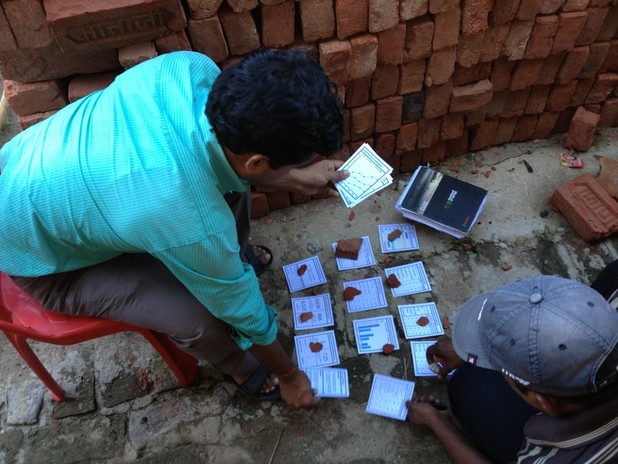December 03, 2013
IDEO.org Fellow, Rafael Smith, reflects on his learning experiences researching and prototyping with Digital Green in India to improve data sharing among stakeholders.
One area of growth I am actively working on during my time with IDEO.org is the art of learning quickly. Call it design research or call it rapid prototyping – either way, I am excited to build an array of tools and techniques that enable me to learn as much as possible as quickly as possible.
IDEO is one of the most creative companies in the world, and as a consultancy, their staff are often not experts on the topics their projects cover. I am discovering that one on the fundamental ingredients in IDEO’s secret sauce is an expertise in the art of learning quickly.
In the past two months my project team has been testing and iterating on research methods for an agricultural based projects in India, working with Digital Green to improve the way data is shared among stakeholders. Our team cannot claim to be experts in agriculture but is has been a delight to see the ingenuity of my colleagues in navigating interviews with users, using research methods and prototypes to aid conversation and unearth new insights.
The following are a few methods that have worked well for us when getting up to speed about new topics:
1) Building Out a System Map
A tangible system map came in handy when working with our client Digital Green, working on new ways to share data among the implementers of their video based agricultural education program. Through interviews and research we felt we were getting a solid understanding of how information flows between the key players of their program. However, we still pushed forward to create a system map - a set of printed icon cards with people, places, services, and arrows to map the entire process with our client. To our surprise we learned about a critical step of informal data reporting that most of our interviewees forgot to mention. The tangibility of this game helps people to process thoughts and remember details that may not come out during a strictly oral interview.
2) Creating a Timeline
Tom Kelley, one of IDEOs founders, tells the story of asking people about their breakfast habits. If I were to ask, “ what do you eat for breakfast?” I might hear an answer like, “ I love to start my mornings with a cup of my favorite coffee, fresh fruits, eggs, and a glass of orange juice.” However, if I were to ask, “what did you eat for breakfast yesterday?” There is a chance I might hear something like,”Yesterday was different -- The kids woke up late, one them couldn’t find their school shoes and the other was crying. So when I finally got everything taken care of I just grabbed a granola bar and ate it on the way to work.” Human-centered design is about meeting people where they are and understanding their reality as well as their aspirations.
The timeline exercise helps build a platform for your users to share a step by step account of their day, week, or month. Asking participants to talk about their day, we drew a timeline on a piece of paper and took detailed notes. This exercise can also be done in small groups with each group member filling out their own worksheet, and can easily be tailored to the age, literacy, and language of your users.
3) Identifying Data Cards
During our second trip to the field with Digital Green, we wanted to learn about what kind of data might be relevant for different stakeholders in their organization. We designed a stack of 15 index cards corresponding to different data points, and asked our end users to rank the cards from most important to least important. After ranking, we walked users through a series of questions to understand how the importance of certain data sets changed depending on whether the information is given to them weekly, monthly or seasonally. The last step in this exercise was to have participants choose the 4 most important cards and make their own data report in front of us. This forced them to focus on the critical pieces of information and discard the “nice to haves,” which provided amazing insights for us as to the most important pieces of data informing their decision-making.
Tom Chi, a hero of mine and former director at Google X (where he led projects such as Google Glass and the self driving car), talks about the two different types of learning. Type 1 is book learning – things that have already been discovered by humanity and that you can read from a textbook. Type 2 is the learning you do on behalf of humanity at that expands our collective sphere of knowledge. Many of the projects we do here at IDEO.org often fall into the latter category, especially during the research phases. What I am learning with IDEO.org is that just as a carpenter needs certain tools in their tool belt, a designer needs research tools in their tool belt to unearth new insights that lead to groundbreaking design.




